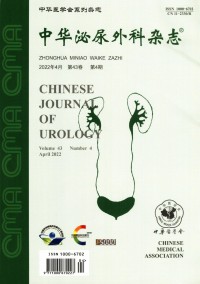A型肉毒杆菌毒素尿道外括约肌注射治疗男性神经源性逼尿肌活动不足的疗效和安全性
Q4 Medicine
引用次数: 0
摘要
目的评价A型肉毒杆菌毒素尿道外括约肌注射治疗男性神经源性逼尿肌活动不足(DU)的临床疗效和安全性。方法自2012年8月至2017年10月进行前瞻性自我对照试验。本研究纳入了神经损伤、排尿困难超过6个月、DU(膀胱收缩指数小于100)的男性患者。排除标准包括急性尿路感染、膀胱结石、良性前列腺增生、尿道狭窄和尿道憩室患者。将100IU BTX-A溶于4ml生理盐水中,将BTX-A溶液注入外泌尿道括约肌的4个不同点(3点、6点、9点和12点),每个点1ml溶液。在基线和注射后12周对患者进行评估。结果包括排尿后残余量(PVR)、最大流速(Qmax)、排尿期最大逼尿肌压(Pdet.max)、最大尿道闭合压(MUCP)、间歇性导管插入术病例数(IC)和生活质量评分(QOL评分)。还记录了不良事件。结果58例男性患者(均来自广东省工伤康复医院),平均年龄28.6岁,患有脑瘫(n=2)、脑血管意外(n=19)和脊髓损伤(n=37)。与基线数据相比,在第12周,PVR(56.68 ml vs.280.11 ml,P<0.001)、Pdet.max(23.95 cmH2O vs.30.01 cmH2O,P=0.019)、Qmax(6.74 ml/s vs.3.28 ml/s,P=0.042)、MUCP(48.25 cmH2O vs.79.34 cmH2O,P<0.001),IC病例数(40 vs.58,P<001)和QOL评分(3.63 vs.5.22,P<0.01)分别存在显著差异。5例出现会阴疼痛,16例出现轻度短暂性血尿。通过药物症状治疗,这些不良事件在3-5天内消失。结论BTX-A尿道外括约肌注射有助于降低神经源性逼尿肌活动不足患者的尿道阻力,提高患者的生活质量。关键词:尿道括约肌;肉毒毒素A;神经源性逼尿肌活动不足;效果;安全本文章由计算机程序翻译,如有差异,请以英文原文为准。
Effect and safety of botulinum toxin A injection in external urethral sphincter for male patients with neurogenic detrusor underactivity
Objective
To assess clinical effect and safety of botulinum toxin A injection in external urethral sphincter for male patient with neurogenic detrusor underactivity(DU).
Methods
A prospective and self-controlled trail was conducted from August 2012 to October 2017. Male patients with nerve injury, dysuria more than 6 months, DU(bladder contractility index less than 100) were enrolled in this study. Exclusion criteria included patients with acute urinary tract infection, bladder stone, benign prostate hyperplasia, urethral stricture and urethral diverticulum.100 IU BTX-A was dissolved in 4ml normal saline, and the solution of BTX- A was injected into 4 different points(3-o’clock, 6-o’clock, 9-o’clock, and 12-o’clock) in external urinary sphincter with each point of 1ml solution. Patients were evaluated at baseline and 12 weeks after injection. The outcomes included post void residual (PVR), maximum flow rate (Qmax), maximum detrusor pressure during voiding phases (Pdet.max), maximum urethral closure pressure (MUCP), the case number of intermittent catheterization (IC)and the score of quality of life (QOL score). Adverse events were also recorded.
Results
A total of 58 male patients (all from Guangdong provincial work injury rehabilitation hospital)with mean age 28.6 years suffered from cerebral palsy (n=2), cerebrovascular accident(n=19)and spinal cord injury(n=37) were included into the study. Compared to baseline data, significant difference were observed at week 12 in PVR (56.68 ml vs. 280.11 ml, P<0.001), Pdet.max(23.95 cmH2O vs. 30.01 cmH2O, P=0.019), Qmax(6.74 ml/s vs. 3.28 ml/s, P=0.042), MUCP(48.25 cmH2O vs. 79.34 cmH2O, P<0.001), the case number of IC(40 vs. 58, P<0.001) and QOL score(3.63 vs.5.22, P<0.001) respectively. 5 cases developed perineal pain and 16 cases developed mild transient haematuria. These adverse events were disappeared by medical symptomatic treatment during 3-5 days.
Conclusions
BTX-A externalurethral sphincter injections help reduce urethra resistance and also improve the quality of life for patients with neurogenic detrusor underactivity.
Key words:
Urethral sphincter; Botulinum toxin A; Neurogenic detrusor underactivity; Effect; Safety
求助全文
通过发布文献求助,成功后即可免费获取论文全文。
去求助
来源期刊

中华泌尿外科杂志
Medicine-Nephrology
CiteScore
0.10
自引率
0.00%
发文量
14180
期刊介绍:
Chinese Journal of Urology (monthly) was founded in 1980. It is a publicly issued academic journal supervised by the China Association for Science and Technology and sponsored by the Chinese Medical Association. It mainly publishes original research papers, reviews and comments in this field. This journal mainly reports on the latest scientific research results and clinical diagnosis and treatment experience in the professional field of urology at home and abroad, as well as basic theoretical research results closely related to clinical practice.
The journal has columns such as treatises, abstracts of treatises, experimental studies, case reports, experience exchanges, reviews, reviews, lectures, etc.
Chinese Journal of Urology has been included in well-known databases such as Peking University Journal (Chinese Journal of Humanities and Social Sciences), CSCD Chinese Science Citation Database Source Journal (including extended version), and also included in American Chemical Abstracts (CA). The journal has been rated as a quality journal by the Association for Science and Technology and as an excellent journal by the Chinese Medical Association.
 求助内容:
求助内容: 应助结果提醒方式:
应助结果提醒方式:


